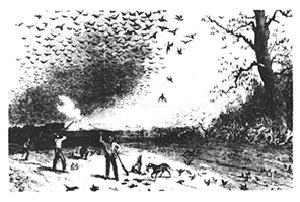Petoskey was the location of the extermination of the last huge breeding colony of passenger pigeon. A state historical marker commemorates the events, including the last great nesting in 1878. That summer, the breeding colony of Pigeons arrived near Crooked Lake. The flock covered 40 square miles and for three months yielded over 50,000 birds a day to hunters. One hunter reportedly killed 3,000,000 of the birds and according to one account earned $60,000. Records estimate between 10-15 million slaughtered. The passenger pigeon was never again seen in the state after 1889.
http://web.archive.org/web/20071009155102/
http://lifeofbirds.com/2007/01/06/was-martha-the-last-pigeon-de-passage/
Both sites were non-existent
From The Scout Report -- Volume 23, Number 46
One Man's Passion For The Passenger Pigeon
https://www.allaboutbirds.org/a-passion-for-a-pigeon
... an essay by Stanley Temple, published by The Cornell Lab of Ornithology's "All About Birds" website. This essay explores the life and work of Arlie William (Bill) Schorger, who studied the passenger pigeon and authored the 1955 book The Passenger Pigeon: Its Natural History and Extinction.
In the early nineteenth century, passenger pigeons were so abundant that flocks of birds were capable of darkening the sky. By 1914, the species was extinct. While it is agreed that commercial hunting and deforestation were responsible for the pigeon's extinction, scientists have long wondered why the species so quickly vanished. This week, a team of evolutionary biologists from the University of California, Santa Cruz published a paper in Science that offers new clues into the pigeon's extinction. In 2014, another team of evolutionary biologists from National Taiwan Normal University examined the DNA of passenger pigeons and discovered that the species had relatively low levels of genetic diversity. This led some scientists to speculate that the species may have been prone to frequent fluctuations in their population size, possibly contributing to their rapid extinction. In examining the mitochondria of 41 passenger pigeons, the UC Santa Cruz team found that certain regions of the pigeon's genome did contain high levels of genetic diversity. The team estimated that the pigeon thrived steadily in large numbers for 20,000 years before its sudden extinction. So, what factors contributed to the pigeon's extinction? For one, low levels of genetic diversity in most regions of the pigeon's genome made it difficult for the species to adapt once their environment was threatened. In addition, the team found evidence that pigeons may have adapted to collaborate in activities like finding food. As a result, a sudden decline in population due to hunting may have quickly threatened the whole species' ability to thrive. [MMB]